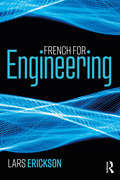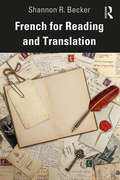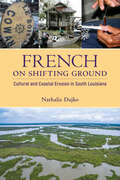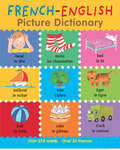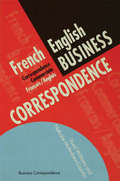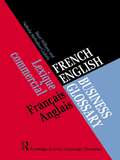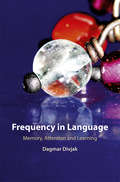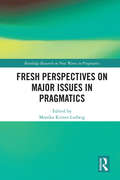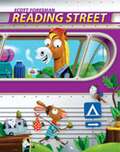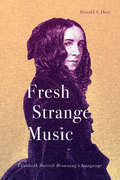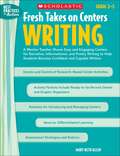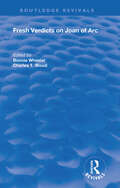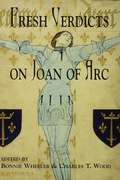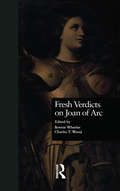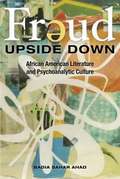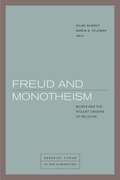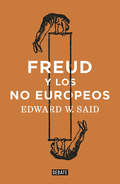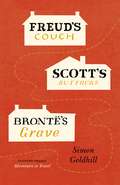- Table View
- List View
French for Engineering
by Lars EricksonFrench for Engineering prepares students to study and intern in France as engineers. Aimed at students at the CEFR B1 or ACTFL Intermediate-High level, the textbook uses a step-by-step progression of language-learning tasks and activities to develop students’ skills at the CEFR C1 or ACTFL Advanced-High level. Authentic documents present students with tasks they will encounter as engineering students or interns in France. Online resources include a teacher handbook and a workbook with vocabulary-building activities, grammar-mastery exercises, and listening and reading comprehension activities, followed by questions requiring critical thinking. It is organized in parallel with the textbook based on the flipped-classroom concept.
French for Reading and Translation
by Shannon R. BeckerFrench for Reading and Translation is a comprehensive introduction to French grammar and vocabulary for those who want to learn to read and understand French, either to conduct academic research or to experience French literature in its original form. Rather than explaining every grammatical concept in tedious detail, the book gives easy-to-follow explanations followed by abundant examples and opportunities to see the language in use. It encourages readers to learn vocabulary by showing them how to break it down and how to recognize related words. It gives learners the opportunity to use various reading strategies as they apply this newfound knowledge to the French passages provided. An engaging guide that will help readers decode the intricacies of the French language, this is an ideal resource for graduate students and researchers consulting French sources.
French on Shifting Ground: Cultural and Coastal Erosion in South Louisiana (America's Third Coast Series)
by Nathalie DajkoIn French on Shifting Ground: Cultural and Coastal Erosion in South Louisiana, Nathalie Dajko introduces readers to the lower Lafourche Basin, Louisiana, where the land, a language, and a way of life are at risk due to climate change, environmental disaster, and coastal erosion. Louisiana French is endangered all around the state, but in the lower Lafourche Basin the shift to English is accompanied by the equally rapid disappearance of the land on which its speakers live. French on Shifting Ground allows both scholars and the general public to get an overview of how rich and diverse the French language in Louisiana is, and serves as a key reminder that Louisiana serves as a prime repository for Native and heritage languages, ranking among the strongest preservation regions in the southern and eastern US. Nathalie Dajko outlines the development of French in the region, highlighting the features that make it unique in the world and including the first published comparison of the way it is spoken by the local American Indian and Cajun populations. She then weaves together evidence from multiple lines of linguistic research, years of extensive participant observation, and personal narratives from the residents themselves to illustrate the ways in which language—in this case French—is as fundamental to the creation of place as is the physical landscape. It is a story at once scholarly and personal: the loss of the land and the concomitant loss of the language have implications for the academic community as well as for the people whose cultures—and identities—are literally at stake.
French-English Picture Dictionary (First Bilingual Picture Dictionaries)
by Louise Millar Susan Martineau Catherine BruzzoneAre there kids in your life who want to learn French? This is the perfect dictionary! Included are pages filled with bright and colorful pictures and bilingual labels to help teach French words to English speaking children.Parents, teachers, and gift givers will find:350 illustrations of familiar objectsPictures labeled with the English word followed by its French equivalentPhonetic spellings of French wordsWords grouped by themesThis dictionary is a fun way for young English-speaking children to build a basic vocabulary in French. It's never too soon to start teaching boys and girls a second language!
French/English Business Correspondence: Correspondance Commerciale Francais/Anglais (Languages For Business Ser.)
by Stuart Williams Nathalie McAndrew CazorlaFrench/English Business Correspondence is a handy reference and learning text for all who use written French for Business. Eighty written communications are simply presented covering memos, letters, faxes and resumes. The situations covered include: * arranging meetings * acknowledging orders * enquiring about products * applying for jobs. With full English translations, this book is suitable for both students and professionals and can be used for either reference or class use.
French/English Business Glossary (Business Language Glossaries Ser.)
by Stuart Williams Nathalie McAndrew CazorlaThis is the essential reference companion for all who use French for business communication. Containing over 5000 words, this handy two-way A-Z glossary covers the most commonly used terms in business. It will help you to communicate with confidence in a wide variety of business situations, and is of equal value to the relative beginner or the fluent speaker. Written by an experienced native and non-native speaker team working in business language education, this unique glossary is an indispensable reference guide for all students and professionals studying or working in business where French is used.
French: From Dialect to Standard
by R. Anthony LodgeWritten as a text, this book looks at the external history of French from its Latin origins to the present day through some of the analytical frameworks developed by contemporary sociolinguistics. French is one of the most highly standardized of the world's languages and the author invites us to see the language as heterogenous, rather than a monolithic entity, using the model proposed by E. Haugen as a useful comparative grid to plot the development of standardization. After an introductory section which examines the dialectalization of Latin in Gaul, the four central chapters of the book are constructed around the basic processes invoved in standardization as identified by Haugen: the selection of norms, the elaboration of function, codification and acceptance. The concluding chapter deals with language variability and the wide gulf that has now developed between French used for formal purposes and that used in everyday speech, with particular reference to Occitan speaking regions. Emphasizing the ordinary speakers of the language, rather than the statesmen or great authors as agents of change, the book combines a traditional history of the language' approach with a sociolinguistic framework to provide a broad and comparative overview of the problem of language standardization.
Frequency in Language: Memory, Attention and Learning (Trends In Linguistics. Studies And Monographs [tilsm] Ser. #244.2)
by Dagmar DivjakCognitive linguists are bound by the cognitive commitment, which is the commitment to providing a characterization of the general principles governing all aspects of human language, in a way that is informed by, and accords with, what is known about the brain and mind from other disciplines. But what do we know about aspects of cognition that are relevant for theories of language? Which insights can help us build cognitive reality into our descriptive practice and move linguistic theorizing forward? This unique study integrates research findings from across the cognitive sciences to generate insights that challenge the way in which frequency has been interpreted in usage-based linguistics. It answers the fundamental questions of why frequency of experience has the effect it has on language development, structure and representation, and what role psychological and neurological explorations of core cognitive processes can play in developing a cognitively more accurate theoretical account of language.
Fresh Perspectives on Major Issues in Pragmatics (Routledge Research on New Waves in Pragmatics)
by Monika Kirner-LudwigThis book showcases new and innovative developments and approaches in pragmatics, spotlighting perspectives from an international range of emerging scholars undertaking cutting-edge research pushing the field in new directions. The volume begins by taking stock of the most up-to-date developments in pragmatics research, as embodied by the work of a newer generation of pragmaticists. Chapters are organized around key areas of development within pragmatics, including intercultural and cross-cultural pragmatics, cognitive pragmatics, and new perspectives on referencing, implicating, and inferring, shedding further light on the ways in which pragmatics increasingly interfaces with other linguistic disciplines and on innovative methodologies. The book also places the focus on pragmatics approaches in languages other than than English, further expanding the borders of research. This book will be of particular interest to scholars in pragmatics interested in staying on top of the latest developments and future directions for the field.
Fresh Reads for Fluency and Comprehension: Grade 3 (Reading Street)
by Scott ForesmanThe third installment of the Reading Street series, Grade 3, delivers structured content designed for children who have a firm foundation in English and Language Arts and are ready to continue on the path to lifelong reading. This curriculum for homeschooling brings together classic reading selections, fun activities and parent/teacher guides to help you develop lessons that boost your student's English and Language Arts learning. As with all levels of Reading Street, Grade 3 was created using educational research to ensure your child is guided through his or her work by age-appropriate and cutting-edge content. Each week, your child will work through a series of reading and writing activities that center around a Big Idea. This structure supports your child's critical thinking skills and ensures he or she builds knowledge suitable for a child in third Grade. <p><p>Reading Street: Grade 3 will give you the tools you need to achieve these learning goals during your homeschool program. Grade 3 comes in a two-volume set that's packed with engaging reading materials and helpful teacher tools. You'll be able to keep tabs on your child's progress through this level by using the assessment materials. If your child needs to revisit a certain lesson, you can ensure he or she does so and fully comprehends the subject.
Fresh Strange Music
by Donald S. HairElizabeth Barrett Browning evokes several figures as muses for her poetry, and one recurring type is the music master. While her writing has always been recognized as highly experimental, the influence and use of music in her work have not been fully examined. Fresh Strange Music defines the exact nature of Browning's experiments and innovations in rhythm, which she called the "animal life" of poetry, and in sound repetition, which she labelled her "rhymatology." Donald Hair approaches Elizabeth Barrett Browning's art with a focus on the power that shapes it - the technical music of her poetry and the recurring beat at the beginning of units of equal time that requires a different system of scansion than conventional metres and syllable counting. Music for Barrett Browning, Hair explains, has momentous implications. In her early poetry, it is the promoter of kindly and loving relations in families and in society. Later in her career, she makes it the basis of nation-building, in her support for the unification of Italy and, more problematically, in her championing of French emperor Napoleon III. Fresh Strange Music traces the development of Barrett Browning's poetics through all her works - from the early An Essay on Mind to Last Poems - showcasing her as a major poet, independently minded, and highly innovative in her rhythms and rhymes.
Fresh Strange Music: Elizabeth Barrett Browning's Language
by Donald S. HairElizabeth Barrett Browning evokes several figures as muses for her poetry, and one recurring type is the music master. While her writing has always been recognized as highly experimental, the influence and use of music in her work have not been fully examined. Fresh Strange Music defines the exact nature of Browning's experiments and innovations in rhythm, which she called the "animal life" of poetry, and in sound repetition, which she labelled her "rhymatology." Donald Hair approaches Elizabeth Barrett Browning's art with a focus on the power that shapes it - the technical music of her poetry and the recurring beat at the beginning of units of equal time that requires a different system of scansion than conventional metres and syllable counting. Music for Barrett Browning, Hair explains, has momentous implications. In her early poetry, it is the promoter of kindly and loving relations in families and in society. Later in her career, she makes it the basis of nation-building, in her support for the unification of Italy and, more problematically, in her championing of French emperor Napoleon III. Fresh Strange Music traces the development of Barrett Browning's poetics through all her works - from the early An Essay on Mind to Last Poems - showcasing her as a major poet, independently minded, and highly innovative in her rhythms and rhymes.
Fresh Takes on Centers: A Mentor Teacher Shares Easy and Engaging Centers for Narrative, Informational, and Poetry Writing to Help Students Become Confident and Capable Writers
by Mary AllenIn this comprehensive resource, veteran teacher, reading specialist, and staff developer Mary Beth Allen shares her time-tested organizational tips and tools for easy-to-implement, research-based writing centers. Reproducible activity packets come complete with student directions, templates, record sheets, and graphic organizers to facilitate independent learning. Mary Beth also offers ideas for differentiation, assessment suggestions and rubrics, record-keeping forms for tracking student progress, and much more. For use with Grades 3.5.
Fresh Takes on Centers: Reading Comprehension
by Mary Beth AllenIn this comprehensive resource, veteran teacher, reading specialist, and staff developer Mary Beth Allen shares her time-tested organizational tips and tools for easy-to-implement, research-based reading centers. Reproducible activity packets come complete with student directions, templates, record sheets, and graphic organizers to facilitate independent learning. Mary Beth also offers ideas for differentiation, assessment suggestions and rubrics, record-keeping forms for tracking student progress, and much more. For use with Grades 3-5.
Fresh Verdicts on Joan of Arc
by Bonnie Wheeler and Charles T. WoodFirst published in 1996. This volume of original essays employs the latest tools of historical analysis, literary criticism, and feminist inquiry to reval why Joan of Arc was such an important figure.
Fresh Verdicts on Joan of Arc (New Middle Ages #Vol. 1976)
by Bonnie Wheeler Charles T. WoodThis volume of original essays employs the latest tools of historical analysis, literary criticism, and feminist inquiry to reval why Joan of Arc was such an important figure.
Fresh Verdicts on Joan of Arc (New Middle Ages #Vol. 1976)
by Bonnie Wheeler Charles T. WoodFirst published in 1996. Routledge is an imprint of Taylor & Francis, an informa company.
Freud Upside Down
by Badia Sahar AhadThis thought-provoking cultural history explores how psychoanalytic theories shaped the works of important African American literary figures. Badia Sahar Ahad details how Nella Larsen, Richard Wright, Jean Toomer, Ralph Ellison, Adrienne Kennedy, and Danzy Senna employed psychoanalytic terms and conceptual models to challenge notions of race and racism in twentieth-century America. Freud Upside Down explores the relationship between these authors and intellectuals and the psychoanalytic movement emerging in the United States over the course of the twentieth century. Examining how psychoanalysis has functioned as a cultural phenomenon within African American literary intellectual communities since the 1920s, Ahad lays out the historiography of the intersections between African American literature and psychoanalysis and considers the creative approaches of African American writers to psychological thought in their work and their personal lives.
Freud and Monotheism: Moses and the Violent Origins of Religion (Berkeley Forum in the Humanities)
by Karen S. Feldman Gilad SharvitOver the last few decades, vibrant debates regarding post-secularism have found inspiration and provocation in the works of Sigmund Freud. A new interest in the interconnection of psychoanalysis, religion and political theory has emerged, allowing Freud’s illuminating examination of the religious and mystical practices in “Obsessive Neurosis and Religious Practices,” and the exegesis of the origins of ethics in religion in Totem and Taboo, to gain currency in recent debates on modernity. In that context, the pivotal role of Freud’s masterpiece, Moses and Monotheism, is widely recognized. Freud and Monotheism brings together fundamental new contributions to discourses on Freud and Moses, as well as new research at the intersections of theology, political theory, and history in Freud’s psychoanalytic work. Highlighting the broad impact of Moses and Monotheism across the humanities, the contributors hail from such diverse disciplines as philosophy, comparative literature, cultural studies, German studies, Jewish studies and psychoanalysis.Jan Assmann and Richard Bernstein, whose books pioneered the earlier debate that initiated the Freud and Moses discourse, seize the opportunity to revisit and revise their groundbreaking work. Gabriele Schwab, Gilad Sharvit, Karen Feldman, and Yael Segalovitz engage with the idiosyncratic, eccentric and fertile nature of the book as a Spӓtstil, and explore radical interpretations of Freud’s literary practice, theory of religion and therapeutic practice. Ronald Hendel offers an alternative history for the Mosaic discourse within the biblical text, Catherine Malabou reconnects Freud’s theory of psychic phylogenesis in Moses and Monotheism to new findings in modern biology and Willi Goetschel relocates Freud in the tradition of works on history that begins with Heine, while Joel Whitebook offers important criticisms of Freud’s main argument about the advance in intellectuality that Freud attributes to Judaism.
Freud in Oz: At the Intersections of Psychoanalysis and Children’s Literature
by Kenneth B. KiddChildren&’s literature has spent decades on the psychiatrist&’s couch, submitting to psychoanalysis by scores of scholars and popular writers alike. Freud in Oz turns the tables, suggesting that psychoanalysts owe a significant and largely unacknowledged debt to books ostensibly written for children. In fact, Kenneth B. Kidd argues, children&’s literature and psychoanalysis have influenced and interacted with each other since Freud published his first case studies.In Freud in Oz, Kidd shows how psychoanalysis developed in part through its engagement with children&’s literature, which it used to articulate and dramatize its themes and methods, turning first to folklore and fairy tales, then to materials from psychoanalysis of children, and thence to children&’s literary texts, especially such classic fantasies as Peter Pan and Alice&’s Adventures in Wonderland. He traces how children&’s literature, and critical response to it, aided the popularization of psychoanalytic theory. With increasing acceptance of psychoanalysis came two new genres of children&’s literature—known today as picture books and young adult novels—that were frequently fashioned as psychological in their forms and functions.Freud in Oz offers a history of reigning theories in the study of children&’s literature and psychoanalysis, providing fresh insights on a diversity of topics, including the view that Maurice Sendak and Bruno Bettelheim can be thought of as rivals, that Sendak&’s makeover of monstrosity helped lead to the likes of the Muppets, and that &“Poohology&” is its own kind of literary criticism—serving up Winnie the Pooh as the poster bear for theorists of widely varying stripes.
Freud y los no europeos (Polirritmos Ser.)
by Edward W. SaidLa controvertida y brillante conferencia que Edward Said pronunció en el Museo Freud de Londres sobre el profundo significado que Moisés y el monoteísmo, según Freud, tienen para la política actual en Oriente Medio. Censurada y finalmente prohibida por el Instituto Freud de Viena, esta controvertida y brillante conferencia pudo ser pronunciada en el Museo Freud de Londres. Aún parecen escucharse los ecos de la inquebrantable voz de Said. El autor presenta en este ensayo una aproximación multidisciplinar, nutriéndose de fuentes procedentes de la literatura, la arqueología y la teoría social, para explorar el profundo significado que Moisés y el monoteísmo, según Sigmund Freud, tienen para la política actual en los países de Oriente Medio. El ensayo, que muestra el permanente interés de Said por la obra de Freud y la influencia de la misma en su propio trabajo, plantea que la tesis de Freud al afirmar que Moisés fue un egipcio socava la idea misma de identidad pura y mantiene que la identidad no puede pensarse ni entenderse sin el reconocimiento previo de los límites que son inherentes a ella. Said sugiere que, desde esta perspectiva, ese sentido de identidad aún no resuelto podría, de haber tomado cuerpo en la realidad política, haber formado una buena base para lograr la comprensión mutua de judíos y palestinos. En lugar de eso, la imparable marcha de Israel dirigida al establecimiento de un estado exclusivamente judío niega cualquier percepción de un pasado más complejo que incluye a ambos.
Freud's Couch Scott's Buttocks Brontë's Grave
by Simon GoldhillThe Victorian era was the high point of literary tourism. Writers such as Charles Dickens, George Eliot, and Sir Walter Scott became celebrities, and readers trekked far and wide for a glimpse of the places where their heroes wrote and thought, walked and talked. Even Shakespeare was roped in, as Victorian entrepreneurs transformed quiet Stratford-upon-Avon into a combination shrine and tourist trap. Stratford continues to lure the tourists today, as do many other sites of literary pilgrimage throughout Britain. And our modern age could have no better guide to such places than Simon Goldhill. In Freud's Couch, Scott’s Buttocks, Brontë's Grave, Goldhill makes a pilgrimage to Sir Walter Scott's baronial mansion, Wordsworth's cottage in the Lake District, the Bront ë parsonage, Shakespeare's birthplace, and Freud's office in Hampstead. Traveling, as much as possible, by methods available to Victorians—and gamely negotiating distractions ranging from broken bicycles to a flock of giggling Japanese schoolgirls—he tries to discern what our forebears were looking for at these sites, as well as what they have to say to the modern mind. What does it matter that Emily Brontë’s hidden passions burned in this specific room? What does it mean, especially now that his fame has faded, that Scott self-consciously built an extravagant castle suitable for Ivanhoe—and star-struck tourists visited it while he was still living there? Or that Freud's meticulous recreation of his Vienna office is now a meticulously preserved museum of itself? Or that Shakespeare’s birthplace features student actors declaiming snippets of his plays . . . in the garden of a house where he almost certainly never wrote a single line? Goldhill brings to these inquiries his trademark wry humor and a lifetime's engagement with literature. The result is a travel book like no other, a reminder that even today, the writing life still has the power to inspire.
Freud's Couch, Scott's Buttocks, Brontë's Grave: Adventures in Travel (Culture Trails)
by Simon GoldhillThe Victorian era was the high point of literary tourism. Writers such as Charles Dickens, George Eliot, and Sir Walter Scott became celebrities, and readers trekked far and wide for a glimpse of the places where their heroes wrote and thought, walked and talked. Even Shakespeare was roped in, as Victorian entrepreneurs transformed quiet Stratford-upon-Avon into a combination shrine and tourist trap. Stratford continues to lure the tourists today, as do many other sites of literary pilgrimage throughout Britain. And our modern age could have no better guide to such places than Simon Goldhill. In Freud's Couch, Scott’s Buttocks, Brontë's Grave, Goldhill makes a pilgrimage to Sir Walter Scott's baronial mansion, Wordsworth's cottage in the Lake District, the Bront ë parsonage, Shakespeare's birthplace, and Freud's office in Hampstead. Traveling, as much as possible, by methods available to Victorians—and gamely negotiating distractions ranging from broken bicycles to a flock of giggling Japanese schoolgirls—he tries to discern what our forebears were looking for at these sites, as well as what they have to say to the modern mind. What does it matter that Emily Brontë’s hidden passions burned in this specific room? What does it mean, especially now that his fame has faded, that Scott self-consciously built an extravagant castle suitable for Ivanhoe—and star-struck tourists visited it while he was still living there? Or that Freud's meticulous recreation of his Vienna office is now a meticulously preserved museum of itself? Or that Shakespeare’s birthplace features student actors declaiming snippets of his plays . . . in the garden of a house where he almost certainly never wrote a single line? Goldhill brings to these inquiries his trademark wry humor and a lifetime's engagement with literature. The result is a travel book like no other, a reminder that even today, the writing life still has the power to inspire.
Freud's Jaw and Other Lost Objects: Fractured Subjectivity in the Face of Cancer
by Lana LinWhat does it mean to live with life-threatening illness? How does one respond to loss? Freud’s Jaw and Other Lost Objects attempts to answer these questions and, as such, illuminates the vulnerabilities of the human body and how human beings suffer harm. In particular, it examines how cancer disrupts feelings of bodily integrity and agency. Employing psychoanalytic theory and literary analysis, Lana Lin tracks three exemplary figures, psychoanalyst Sigmund Freud, poet Audre Lorde, and literary and queer theorist Eve Kosofsky Sedgwick. Freud’s sixteen-year ordeal with a prosthetic jaw, the result of oral cancer, demonstrates the powers and failures of prosthetic objects in warding off physical and psychic fragmentation. Lorde’s life writing reveals how losing a breast to cancer is experienced as yet another attack directed toward her racially and sexually vilified body. Sedgwick’s memoir and breast cancer advice column negotiate her morbidity by disseminating a public discourse of love and pedagogy. Lin concludes with an analysis of reparative efforts at the rival Freud Museums in London and Vienna. The disassembled Freudian archive, like the subjectivities-in-dissolution upon which the book focuses, shows how the labor of integration is tethered to persistent discontinuities.Freud’s Jaw asks what are the psychic effects of surviving in proximity to one’s mortality, and it suggests that violences stemming from social, cultural, and biological environments condition the burden of such injury. Drawing on psychoanalyst Melanie Klein’s concept of “reparation,” wherein constructive forces are harnessed to repair damage to internal psychic objects, Lin proposes that the prospect of imminent destruction paradoxically incites creativity. The afflicted are obliged to devise means to reinstate, at least temporarily, their destabilized physical and psychic unity through creative, reparative projects of love and writing.
Freud’s Rome: Psychoanalysis and Latin Poetry
by Ellen OliensisThis book is a meditation on the role of psychoanalysis within Latin literary studies. Neither a sceptic nor a true believer, Oliensis adopts a pragmatic approach to her subject, emphasizing what psychoanalytic theory has to contribute to interpretation. Drawing especially on Freud's work on dreams and slips, she spotlights textual phenomena that cannot be securely anchored in any intention or psyche but that nevertheless, or for that very reason, seem fraught with meaning; the 'textual unconscious' is her name for the indefinite place from which these phenomena erupt, or which they retroactively constitute, as a kind of 'unconsciousness-effect'. The discussion is organized around three key topics in psychoanalysis - mourning, motherhood, and the origins of sexual difference - and takes the poetry of Catullus, Virgil, and Ovid as its point of reference. A brief afterword considers Freud's own witting and unwitting engagement with the idea of Rome.
